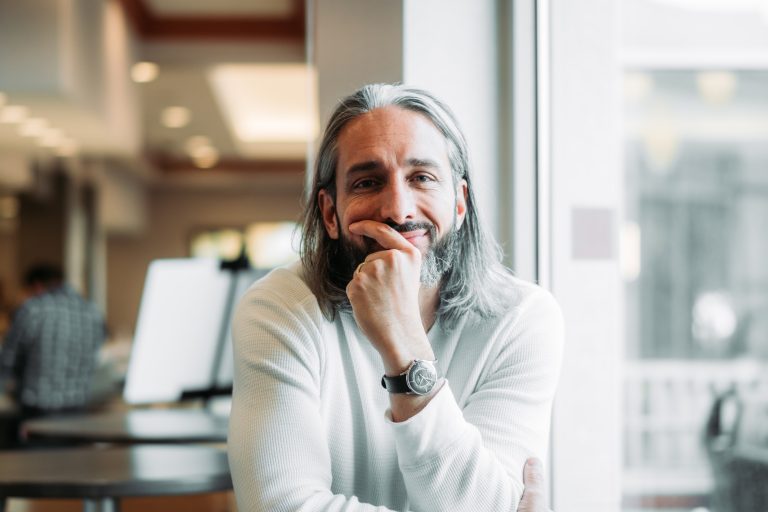I love concerts.
Watching great performers in person is magical. Not only do I get to be entertained, I get to learn and be inspired as well.
This has been especially true since creating and performing my theatrical keynote. I can appreciate the intention, practice, presence, and so many dimensions that may have gone unnoticed before doing my play and comedy.
To my surprise, some of the people who have inspired me the most are the ones I knew the least.
One example, Garth Brooks. I saw him twice on his stadium tour in 2022. Magic. He somehow makes everyone feel seen in a massive crowd.
More recently, I was able to see the final date of Taylor Swift’s SoFi stadium performance.
It.
Was.
Epic.
My sister-in-law is a Swifty and invited me to tag along. I’m so glad I did.
Almost every woman in the stadium had Taylor’s words on their shirts. She tapped into emotion that made people feel seen and heard.
Her words connect with people.
The woman seated behind me screamed at the top of her lungs. Every. Single. Word. Blood-curdling screams. So I guess Taylor may have to be her voice moving forward!
I get it. Some albums and songs anchor emotions to different times in my life. Merely playing the song can take me back or connect me to an emotion or put me in a better mood.
As a spectator, I found Taylor’s work ethic inspiring and her performance world-class—unlike anything I had ever seen. It was a demonstration of the power of purpose, passion, and talent that comes together with vision and collaboration.
But here is what changed my life.
At the end of the show, Taylor announced her 1989 album re-release, Taylor’s Edition.
People went berserk. (You may have even heard about how these shows measured a 2.3 magnitude earthquake.)
Why were they so excited about a re-release? Because a venture capital firm bought Taylor’s library.
Taylor said,
“I learned about Scooter Braun’s purchase of my masters as it was announced to the world. All I could think about was the incessant, manipulative bullying I’ve received at his hands for years.”
But she didn’t play the victim. Instead, she did something genius. Taylor owns the derivative and master rights so she can re-record the music: Taylor’s Edition. Taylor’s Edition could include new songs as well, adding more value.
This immediately struck me because of my personal experience.
After selling Wealth Factory in June of 2021, I remained involved with a licensing deal. In the summer of 2023, the CEO unilaterally changed the deal. Throughout much of the concert, my mind was occupied with discontent over those changes.
The links in two of my most popular books, Killing Sacred Cows and What Would the Rockefellers Do? point to Wealth Factory. These gave some bonuses people could get for opting into their database, but could leave people confused. They might wonder if it was an endorsement from me or I was still or would be involved.
It was time to clean this up and, in the process, add more value.
I retained the rights to Killing Sacred Cows, but Wealth Factory had initially bought the rights to What Would the Rockefellers Do?. A month after the concert, I secured and regained the rights to What Would the Rockefellers Do? while fully severing my ties and relationship with Wealth Factory.
I didn’t write a breakup song—I’ll leave those to Taylor.
It was with much thought and deliberation that I ended the relationship with a company I founded, especially considering my love and respect for the content, tech, and marketing team (Mat, Jex, Tom, Stephen, and Nordy).
My philosophy is we win when we play, and my involvement didn’t feel like play. Even though I had sold the company, I was still doing videos and webinars, and also had responsibilities with the licensing deal.
My values of connect and engage, value and vulnerability, entertain and transform were no longer aligned with the CEO’s structure of the company, his models or direction—or our relationship, for that matter. It was no longer aligned with my winning game.
I’m a different person since I wrote these books. Raising kids, seeing different market cycles, maturing. And thanks to AJ Harper, I’m a better writer. AJ was the screenwriter for my theatrical keynote and helped me find love for writing. Her book, Write a Must-Read, showed me ways to focus on the reader.
When I wrote Killing Sacred Cows, I hadn’t developed my voice. I was a novice, and was even afraid to write. I was hesitant because I didn’t have confidence or wasn’t sure I could write.
So I hired Stephen Palmer as a ghostwriter. Someone who had been deeply impacted by my content. Stephen had watched every video I created and attended multiple events. Even though he hadn’t written a book before, he is smart, well-read, and loved to write.
Stephen and I recently finished editing the manuscript for Killing Sacred Cows 2.0: Crush Money Myths, Live Your Richest Life. We took time to reflect, critique, and especially have tremendous gratitude for the content and impact of the original book. Killing Sacred Cows is just as relevant today as when we wrote the book, but even more important.
Fifteen years later, the four truly revolutionary concepts in Killing Sacred Cows give people the insight to avoid misinformation, permission to succeed, and build sustainable wealth. I have so much passion for helping people understand the revolutionary concepts around debt, scarcity/abundance, and how to unlock assets increasing cash flow.
The truths behind the myths of “Avoid debt like the plague,” the “Finite Pie,” and “Self-Insurance” are game-changers on how to view money and unlock wealth.
With $22 trillion in mutual funds/ETFs, people are still prey for the dangerous and dogmatic accumulation models and philosophies. Accumulation believes it takes money to make money, high risk equals high return, and you are in it for the long haul.
What about cash flow?
What about efficiency and plugging financial leaks?
What about Investor DNA to reduce risk?
What about economic independence instead of retirement?
The original version of Killing Sacred Cows was about 93,000 words. Even as we released the book, it was longer than I wanted it to be, but the extra words made for a bigger spine. This would make it more visible and stand out at the bookstore (not needed in today’s world).
I’m pleased to report the new version is just 65,000 words. We’ve trimmed it down by a third, while making the concepts even more powerful than before.
The most common reason that people didn’t give this a five-star review was redundancy. We listened.
The second reason, they wanted more solutions. So I created a course and workbook for Investor DNA discovery, how to create and maximize mental capital, and establishing and designing your richest life. This is included as a bonus with the book.
If you have read the first version, I think you’ll love the focus and new insights with Investor DNA in version 2. You’ll also find clear distinctions in the relationship between Investor DNA, Soul Purpose, and Human Life Value.
In 2016, Michael Isom and I decided to write What Would the Rockefellers Do? together. Michael and I started studying finance together way back in 1999. Michael provided the case studies and calculations and tours the country speaking on the concepts in the book.
Since 2016, our economy has changed. Interest rates have drastically risen. And so has the demand for this book. What Would the Rockefellers Do? has tremendous popularity with almost 2,300 organic reviews on Amazon with an average of 4.6 out of 5 stars. This has given us a tremendous amount of feedback to make adjustments and improvements.
Michael and I are amazed at how popular and impactful this book has been.
A past mentor of mine was given the book by his financial team (they didn’t know we knew each other). Rick showed me his marked-up book that he read and re-read, telling me it was the best financial book he had ever read—and he is in the world of finance.
When the book originally came out, Mark Ford, aka Michael Masterson, wrote an unsolicited endorsement and said the pieces on legacy changed how he viewed and will handle his plan to pass on wealth. He also mentioned that there were parts on insurance that were too long and even redundant. Again, we listened.
Ironically, when writing this book, I was listening to my wife’s playlist on a flight. The person sitting next to me kept reading my screen and asking me questions about the book. She also started laughing when a Taylor Swift song was playing on my Spotify.
In the new version, Michael and I filmed videos to go with a Legacy course. You get the Legacy Toolkit and course included with the book.
The purpose of the course and expansion is to demonstrate that legacy isn’t just for the already wealthy. Legacy can begin today, regardless of your financial situation.
We also removed any confusing terminology or marketing speak and Michael added more illustrations to support the points in the book.
Some key concepts in the updated and expanded version demonstrate how you can have a better asset allocation choice where interest rate fluctuations won’t put your capital at risk.
We added an entirely new chapter sharing the Legacy Rings and how they intersect with the Rockefeller Method.
I did more research finding that not only did the Rockefellers pass on wealth for generations, they shared the concepts with their business partners and they are perpetuating family wealth as well. It comes down to the right trusts and the right insurance combined with the family philosophy being captured, a comprehensive team, and family retreats. All are included in the expanded version and course.
Killing Sacred Cows and What Would the Rockefellers Do? are intellectual property. And just like I improve my physical properties, it was time for a book remodel!
And finally, bringing it back to Taylor Swift. Her speech at the Grammy’s was captivating and inspiring, and I almost went to sleep and missed it.
Luckily, I turned on the TV just in time to hear her say,
“For me, the award is the work. All I want to do is keep being able to do this. I love it so much. It makes me so happy. It makes me unbelievably blown away that it makes some people happy who voted for this award too. All I want to do is keep doing this. So thank you so much for giving me the opportunity to do what I love so much. Mind blown.”
Create a life from which you don’t want to retire.
Taylor wasn’t happy when her library of music was bought, but she didn’t play the victim. She chose to do more of what she loves.
And I didn’t retire after selling my business. To the contrary, my best work is yet to come.
By retiring from the things I don’t love or no longer represent me, I am creating, working, and sharing value, aligned with my values.



